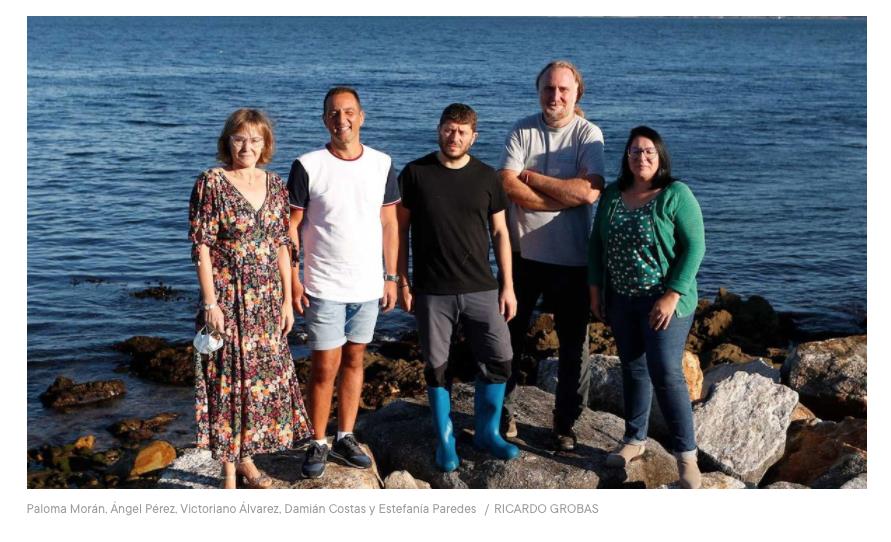MYTUNISEX, THE SHERPA JOURNEYS PROJECT THAT OPENS THE DOOR TO PRODUCE BREEDING OF FEMALE MUSSELS, THE PREFERRED FOR ITS ORANGE COLOR
23.09.2021
Obtaining mussel seed with which to feed their rafts has been, in recent years, a real problem for Galician bateeiros. On the one hand, because conflicts with other sectors are spreading more and more along the Galician coast. On the other hand, because even the stones on which this bivalve used to be best raised appear, lately, too clean. In this context, the MytUniSex project gains relevance, the initiative of a group of researchers from the University of Vigo who have decided to take advantage of the knowledge acquired during years of research to develop tools that can benefit the sector. MytUniSex, despite being still in the embryonic phase as a business project, opens many doors to the cultivation of the Galician mussel. It will be necessary to see if the sector is willing to cross them.

Ángel Pérez, an expert in mussel DNA, heads a team that includes several scientists associated with CIM-UVigo. Damián Costas brings his knowledge of marine farming; Sofía Blanco in molecular techniques; Estefanía Paredes is an expert in cryopreservation; Juan Pasantes, in cytogenetics and Paloma Morán, in molecular biology. The knowledge of one and the other is fundamental when it comes to responding to two of the great challenges that MytUniSex wants to address: to achieve the production of a mussel with greater commercial value and, at the same time, to achieve the production of seed in the laboratory and throughout of the whole year.
But is it possible to breed mussels in the laboratory? The technology and procedure to artificially induce the release of gametes and carry out fertilization is controlled, and is carried out by subjecting the specimens to changes in temperature - this is the determining factor also in the natural environment. In addition, Estefanía Paredes is doing research on the possibility of cryopreserving gametes and larvae whose development, at a certain moment, “stops, is left on hold until, with the appropriate treatment, they are reactivated and continue to grow. This would allow us to supply seed at any time of the year ”, according to Ángel Pérez. This baby could be transferred to the natural environment when it reaches a minimum size to be stuck on the ropes of the rafts.
The MyUniSex project is also built on another circumstance: although it is not known exactly "what is the mechanism that determines sex in the mussel", what is clear is that the key factor is found in the reproductive female. It has been found that there are females that have progeny made up of only females, others whose offspring is male, and others that generate mixed progeny. By selecting the mothers, you can select the type of seed crop you want to have. In this process, no type of genetic modification is contemplated. "Not at all," explains Ángel Pérez. His project is committed to generating unisex breeding lines, only of females, after having verified that 95% of the mussels that reach the orange shade preferred by the market - and therefore have greater commercial interest - are female, «while the pieces with paler or whitish tones are, in 95% of cases, males ”.
Pieces of intense orange color and spherifications to make caviar of this bivalve
If 95% of the mussel pieces with an intense orange color -the preferred in many markets to which Galician mussels arrive- are female, and if there is the possibility of selecting breeders whose progeny is made up exclusively of females, the possibility of «To generate mussel lines of high commercial interest». That is the cornerstone on which the MyUniSex project arose, a plan that seeks to connect part of the knowledge that had been obtained through basic research in mussel genetics with its sectoral applications, in the field of cultivation and transformation.
The possibility of scheduling this type of harvest, which seems to guarantee the orange hue of the food, has aroused the interest of several canneries to which the initiative has already been proposed. This, in addition, still includes a third pillar: the elaboration of a gourmet by-product: mussel caviar. By controlling the release of gametes, "we obtain a mass of oocytes that, using techniques such as spherification, would allow us to create a kind of caviar", explains Ángel Pérez.
To get to try it, you have to give time. Although thanks to its entry into Sherpa do Mar, the plan to generate added value in the mussel sector and give wings to innovation is already underway.
About Sherpa do Mar
Sherpa do Mar is a project integrated in the INTERREG VA Spain-Portugal Cross-Border Cooperation Program (POCTEP) 2014-2020, co-financed 75% by ERDF funds, whose purpose is to launch a cross-border network of entrepreneurship in the marine-maritime field and blue economy, through the Sherpa Journeys program, which favors job creation and increased business competitiveness through the promotion of technology-based companies.
The project is led by the University of Vigo, through the REDE research group, Campus do Mar and the R&D Office, and has the participation of the Vigo Free Zone Consortium, the Galician Innovation Agency (GAIN) and the universities of Santiago and A Coruña. On the part of Portugal it has the participation of the Asprela Technology Transfer Association (UPTEC), UPorto-Innovação of the University of Porto (UPIN), the Interdisciplinary Center for Marine and Environmental Research (CIIMAR) and the Fórum Oceano-Associação da Economia do Mar.
SOURCE: La Voz de Galicia


